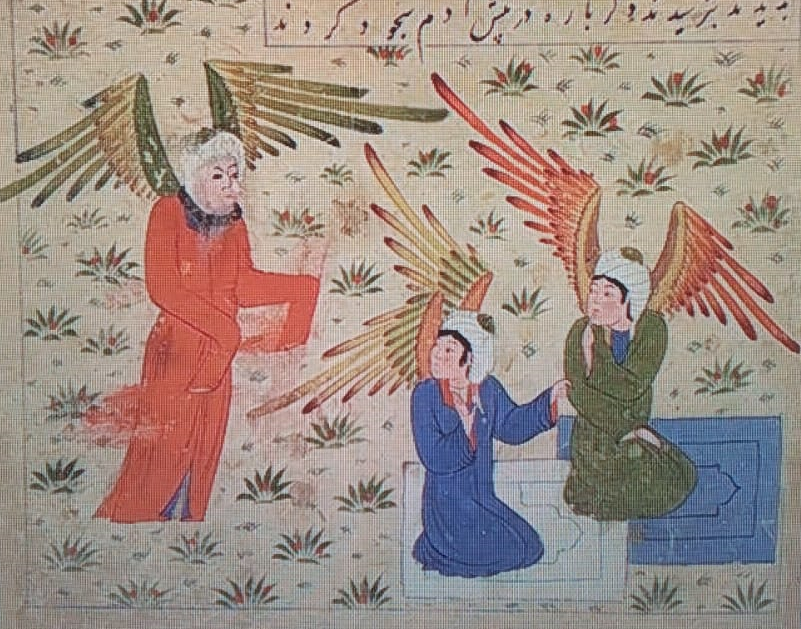|
Azazil
In many Islamic and Islam-related traditions, Azazil (Arabic: عزازيل ''ʿAzāzīl'', also known as Arabic: حارث ''Ḥārith'') is the legendary prototype of the devil in Islamic culture. Azazil was considered to be among the nearest to God's throne, but because he sinned through pride, he became a devil. In Islamic tradition, ''Azazil'' is usually seen as the original name of Iblis, before he was expelled from heaven. Although Azazil is mostly portrayed as an archangel, who was already created when God made the jinn, in some reports Azazil is considered created as a jinni first but elevated to the rank of the angels. In some mystical interpretations of Islam, like Sufism, Ismailism and Alevism, Azazil's fall happened before the creation of the world and therefore, becomes the originator of sin in this world. Etymology and naming The name is derived from Azazel, a fallen angel in the Apocalypse of Abraham. Here, Azazel is said to have lost his former glory as a serva ... [...More Info...] [...Related Items...] OR: [Wikipedia] [Google] [Baidu] |
Iblis
Iblis ( ar, إِبْلِيس, translit=Iblīs), alternatively known as Eblīs, is the leader of the devils () in Islam. According to the Quran, Iblis was thrown out of heaven, after he refused to prostrate himself before Adam. Regarding the origin and nature of Iblis, there are two different viewpoints. In the first version, before Iblis was cast down from heaven, he used to be a high-ranking angel (''Karub'') called Azazil, appointed by God to obliterate the original disobedient inhabitants of the earth, who were replaced with humans, as more obedient creatures. After Iblis objected to God's decision to create a successor (), he was punished by being relegated and cast down to earth as a (devil). In the alternative account, God created Iblis from the fires beneath the seventh earth. Worshipping God for thousands of years, Iblis ascended to the surface, whereupon, thanks to his pertinacious servitude, he rose until he reached the company of angels in the seventh heaven. Wh ... [...More Info...] [...Related Items...] OR: [Wikipedia] [Google] [Baidu] |
Shaitan
' (; ''devils'' or ''demons''), singular: (شَيْطَان) are evil spirits in Islam, inciting humans (and jinn) to sin by "whispering" (وَسْوَسَة, “waswasah”) to their qalb, hearts (قَلْب ''qalb''). Folklore suggests that they are grotesque creatures created from Jahannam, hell-fire.el-Zein, Amira (2009). Islam, Arabs, and Intelligent World of the Jinn. Syracuse, NY: Syracuse University Press. ISBN 978-0-8156-5070-6. The Quran speaks of various ways that shayāṭīn tempt humans into sin. They may teach sorcery, assault heaven to steal the news of the angels, or lurk near humans without being seen. Related to the shayāṭīn is Iblis (Satan), who is generally considered to be their leader. Hadith, Hadith-literature holds shayāṭīn responsible for various calamities which may affect personal life. Both hadith and folklore usually speak about shayāṭīn in abstract terms, describing their evil influence only. During Ramadan, the shayāṭīn are chained ... [...More Info...] [...Related Items...] OR: [Wikipedia] [Google] [Baidu] |
Shaitan
' (; ''devils'' or ''demons''), singular: (شَيْطَان) are evil spirits in Islam, inciting humans (and jinn) to sin by "whispering" (وَسْوَسَة, “waswasah”) to their qalb, hearts (قَلْب ''qalb''). Folklore suggests that they are grotesque creatures created from Jahannam, hell-fire.el-Zein, Amira (2009). Islam, Arabs, and Intelligent World of the Jinn. Syracuse, NY: Syracuse University Press. ISBN 978-0-8156-5070-6. The Quran speaks of various ways that shayāṭīn tempt humans into sin. They may teach sorcery, assault heaven to steal the news of the angels, or lurk near humans without being seen. Related to the shayāṭīn is Iblis (Satan), who is generally considered to be their leader. Hadith, Hadith-literature holds shayāṭīn responsible for various calamities which may affect personal life. Both hadith and folklore usually speak about shayāṭīn in abstract terms, describing their evil influence only. During Ramadan, the shayāṭīn are chained ... [...More Info...] [...Related Items...] OR: [Wikipedia] [Google] [Baidu] |
Devil
A devil is the personification of evil as it is conceived in various cultures and religious traditions. It is seen as the objectification of a hostile and destructive force. Jeffrey Burton Russell states that the different conceptions of the devil can be summed up as 1) a principle of evil independent from God, 2) an aspect of God, 3) a created being turning evil (a ''fallen angel''), and 4) a symbol of human evil. Each tradition, culture, and religion with a devil in its mythos offers a different lens on manifestations of evil.Jeffrey Burton Russell, ''The Devil: Perceptions of Evil from Antiquity to Primitive Christianity'', Cornell University Press 1987 , pp. 41–75 The history of these perspectives intertwines with theology, mythology, psychiatry, art, and literature developing independently within each of the traditions. It occurs historically in many contexts and cultures, and is given many different names— Satan, Lucifer, Beelzebub, Mephistopheles, Iblis—and at ... [...More Info...] [...Related Items...] OR: [Wikipedia] [Google] [Baidu] |

_meet_Adam.png)